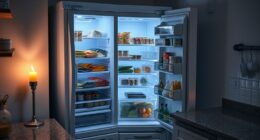To keep your pantry and cabinets safe and efficient, place frequently used items within easy reach and store heavier or less-used items lower or higher to prevent accidents. Use clear containers and labels to organize dry goods, and incorporate pull-out shelves or lazy Susans for better accessibility. Regularly declutter and clean to prevent safety hazards and maintain fresh, organized space. Keep extra safety tips in mind—your organized kitchen is just steps away.
Key Takeaways
- Use clear containers and labels for dry goods to improve visibility and prevent spills.
- Store frequently used items at eye level for quick access and efficiency.
- Allocate designated zones for appliances, pantry items, and utensils to organize space effectively.
- Regularly discard expired or unused food to maintain safety and reduce clutter.
- Incorporate vertical storage options like shelves and pull-out drawers to maximize space and enhance safety.

A well-organized kitchen can transform your cooking experience and save you time every day. When you focus on efficient pantry and cabinet arrangements, you make meal prep smoother and reduce frustration. One of the first steps is to pay attention to appliance placement. Keep commonly used appliances like your toaster, blender, or coffee maker on a designated countertop or in easily accessible cabinets. This way, you avoid clutter and save time searching for them. Store less frequently used appliances in higher or less accessible cabinets, freeing up space for everyday essentials. Group similar items together—pots with pots, baking supplies in one area—so you can quickly find what you need without rummaging through clutter. Proper appliance placement not only makes your kitchen more functional but also helps maintain safety. For instance, place heavy appliances at waist level to prevent accidents when lifting or moving them. Keep small appliances away from the sink and stove to avoid moisture damage or fire hazards. When your appliances are correctly positioned, it’s easier to keep them clean. Regular cleaning routines become more manageable because you’ll naturally wipe down surfaces where appliances sit and keep dust and crumbs from accumulating behind and underneath them. Incorporate cleaning routines into your weekly schedule—wipe down appliance surfaces, clean behind the fridge, and degrease the stovetop—so grime doesn’t build up. This habit not only prolongs the life of your appliances but also keeps your kitchen hygienic and inviting. Additionally, choosing the right storage solutions can help you organize your space more effectively and prevent clutter from returning. Using efficient storage methods, such as pull-out shelves and lazy Susans, can further optimize space and accessibility. Inside your cabinets and pantry, organization plays a critical role in efficiency and safety. Use clear containers for dry goods, so you always know when you’re running low, and label everything clearly. This minimizes the time spent searching for ingredients or utensils, especially during busy mornings or dinner prep. Arrange items by frequency of use—everyday staples in front, specialty items toward the back. For safety, store sharp knives in a designated drawer or knife block, away from children’s reach, and keep heavy or bulky items on lower shelves to prevent accidents. Make it a point to regularly declutter your pantry and cabinets, discarding expired food and donating unused items. This keeps your storage areas neat and prevents potential safety hazards like spoiled food or pests. Additionally, implementing vertical storage solutions can maximize space and improve accessibility, making your kitchen even more efficient.
Frequently Asked Questions
How Often Should I Declutter My Pantry and Cabinets?
You should declutter your pantry and cabinets every three to six months to keep things organized and prevent expired items. This also gives you a chance to implement meal prep tips and adjust container sizing for better storage. Regular decluttering helps you identify what you no longer need, making room for fresh ingredients. Stay proactive to maintain an efficient kitchen, saving time and reducing stress during busy meal times.
What Are the Best Labels for Pantry Organization?
Think of labels as the GPS for your pantry. You should choose label materials that withstand moisture and wear, like waterproof or laminated options. For label design, go for clear, bold fonts and simple layouts to make items easy to find at a glance. This way, your labels guide you effortlessly, turning your pantry into a well-organized space where everything has its rightful place.
How Can I Prevent Pests in My Pantry?
To prevent pests in your pantry, focus on pest prevention and storage maintenance. Keep your pantry clean by wiping up spills immediately and regularly inspecting for signs of pests. Store food in airtight containers to block entry points and prevent contamination. Rotate stock to avoid expired items attracting bugs. Sealing cracks and keeping the area dry also helps, ensuring pests don’t find a cozy home in your pantry.
What Safety Tips Should I Follow When Organizing?
When organizing, you should follow safety tips like child-proofing your pantry to prevent accidents and storing hazardous items out of kids’ reach. Always keep fire safety precautions in mind by avoiding clutter near heat sources and ensuring your smoke detectors work. Use sturdy containers and labels to prevent spills, and regularly check for damages. These steps help create a safe, efficient space for everyone in your household.
Are There Eco-Friendly Storage Options for Kitchens?
When exploring eco-friendly storage options for your kitchen, you can opt for reusable containers to reduce waste and keep food fresh. Bamboo shelves are a sustainable choice because they’re durable and renewable. You’ll love how these eco-friendly options help your kitchen stay organized while being kind to the environment. Incorporate reusable containers for snacks and ingredients, and install bamboo shelves for a stylish, eco-conscious touch that’s both functional and sustainable.
Conclusion
By implementing these tips, you’ll turn your kitchen into a safe, efficient space where everything has its place. Staying organized might seem like a tall order at first, but remember, a cluttered kitchen is like a ticking time bomb. Keep at it, and you’ll find that a tidy pantry and cabinets not only save time but also bring peace of mind. When your kitchen’s in order, cooking becomes a joy, not a chore.









